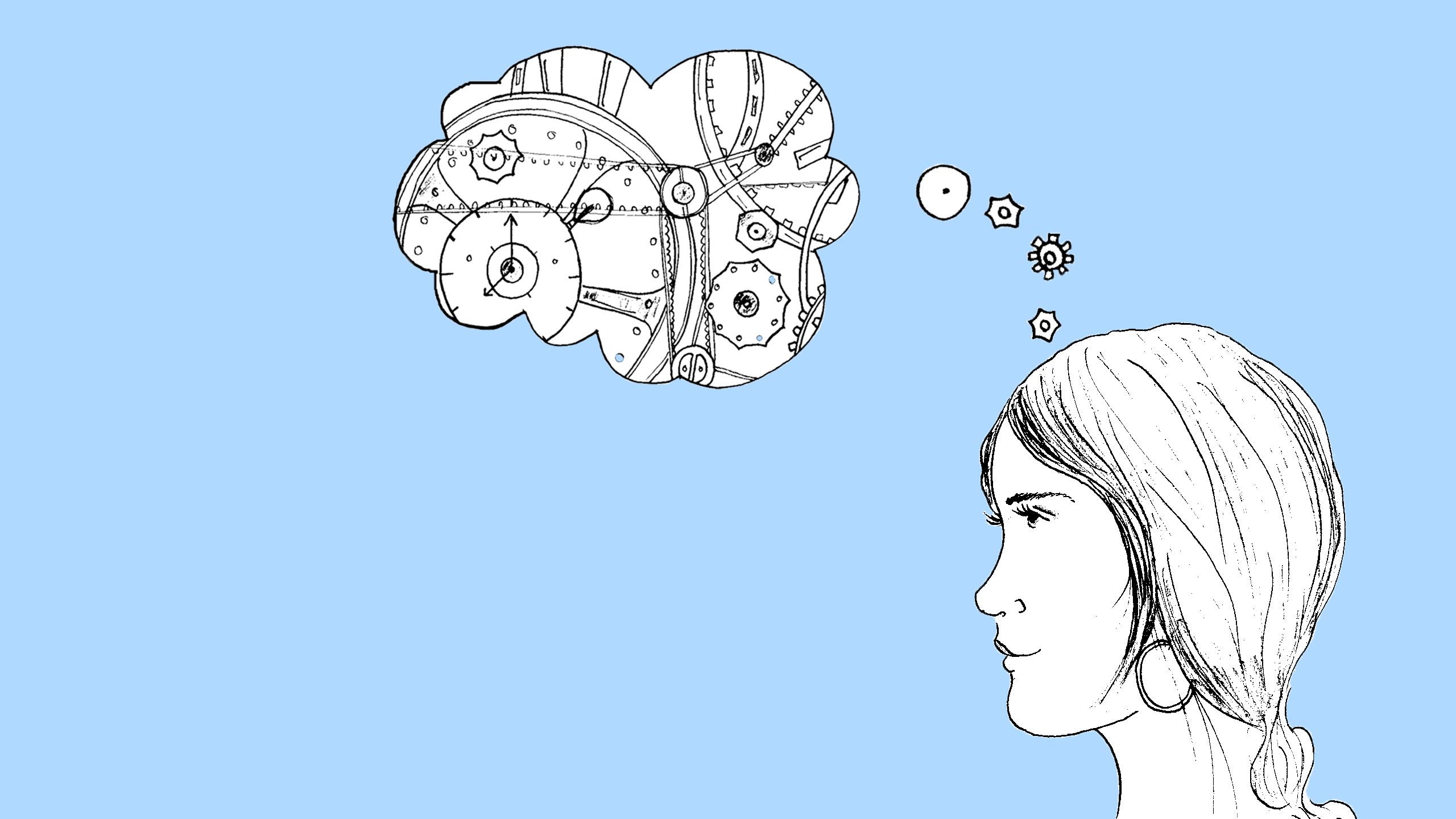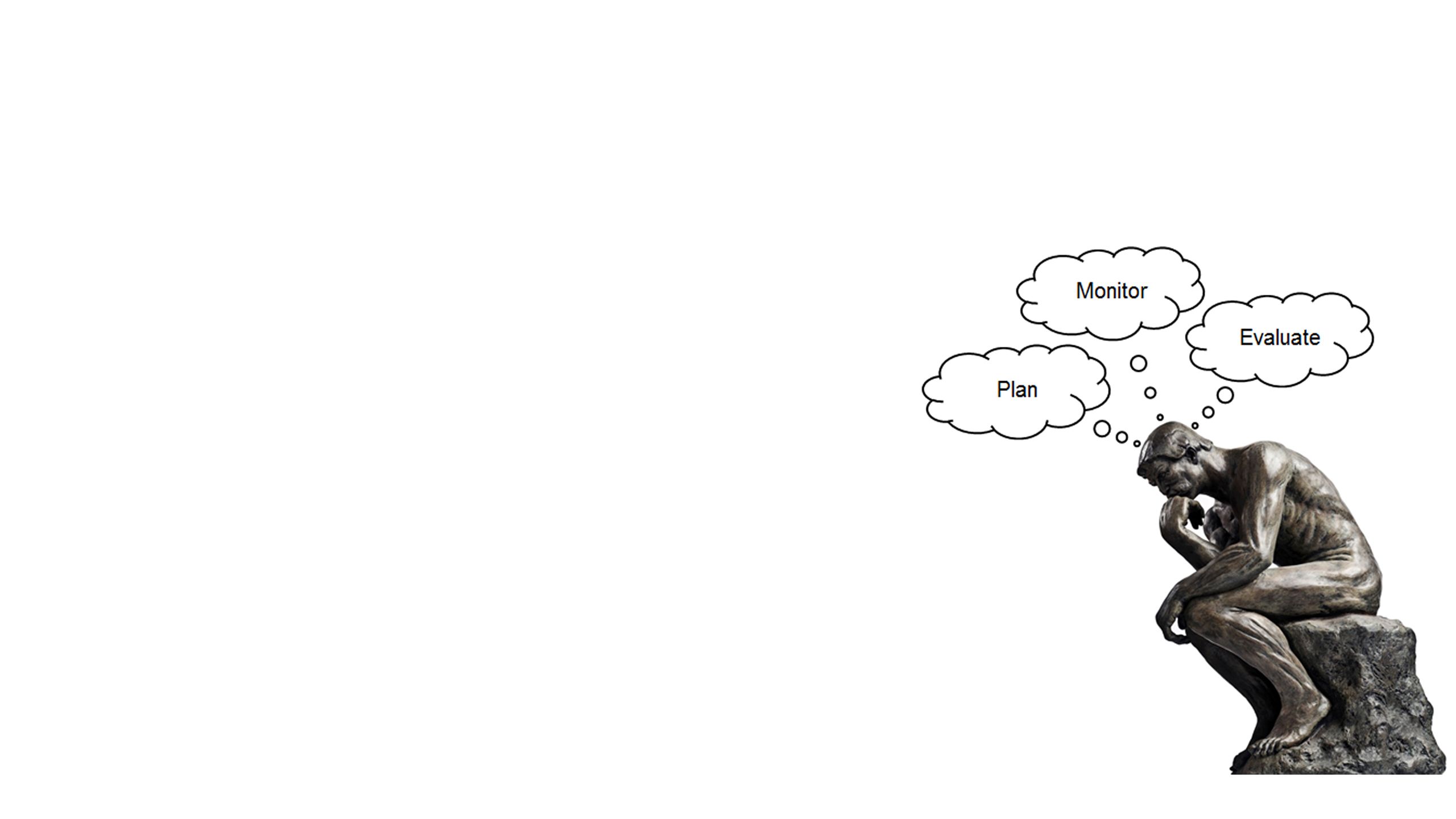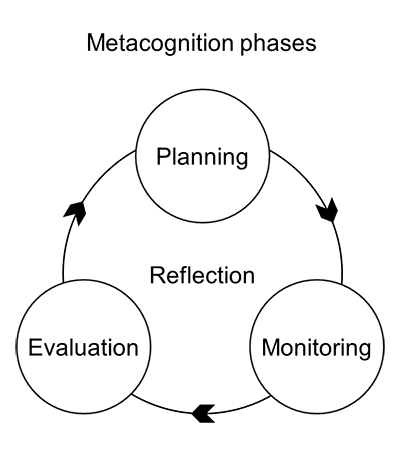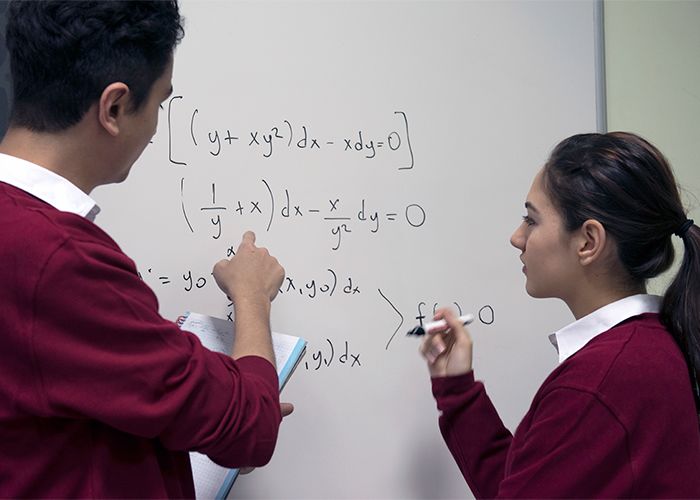Getting started with Metacognition

What is metacognition?
Metacognition describes the processes involved when learners plan, monitor, evaluate and make changes to their own learning behaviours.
Metacognition is often considered to have two dimensions: metacognitive knowledge and metacognitive regulation.
Metacognitive knowledge refers to what learners know about learning. This includes:
- the learner’s knowledge of their own cognitive abilities (e.g. ‘I have trouble remembering dates in history’)
- the learner’s knowledge of particular tasks (e.g. ‘The ideas in this chapter that I’m going to read are complex’)
- the learner’s knowledge of different strategies that are available to them and when they are appropriate to the task (e.g. ‘If I scan the text first it will help me to understand the overall meaning').
Metacognitive regulation refers to what learners do about learning. It describes how learners monitor and control their cognitive processes. For example, a learner might realise that a particular strategy is not achieving the results they want, so they decide to try a different strategy.
During the planning phase, learners think about the learning goal the teacher has set and consider how they will approach the task and which strategies they will use. At this stage, it is helpful for learners to ask themselves:
‘What am I being asked to do?’
‘Which strategies will I use?’
‘Are there any strategies that I have used before that might be useful?’
During the monitoring phase, learners implement their plan and monitor the progress they are making towards their learning goal.
Students might decide to make changes to the strategies they are using if these are not working. As students work through the task, it will help them to ask themselves:
‘Is the strategy that I am using working?’
‘Do I need to try something different?’
During the evaluation phase, students determine how successful the strategy they used was in helping them to achieve their learning goal. To promote evaluation, students could consider:
‘How well did I do?’
‘What didn’t go well?’ ‘What could I do differently next time?’
‘What went well?’ ‘What other types of problem can I use this strategy for?’
Reflection is a fundamental part of the plan-monitor-evaluate process. Encouraging learners to self-question throughout the process will support this reflection.
In the rest of this unit, we will look at the basics of metacognition in more detail. We will discuss the benefits, look at the theory behind metacognition and discover some practical examples.
Throughout the unit, you will be encouraged to reflect upon metacognition and to think about how you can integrate it into your own classroom practice. At the end of the unit there is a glossary of key words and phrases.
What is research behind metacognition?
Educational psychologists have long promoted the importance of metacognition for supporting student learning and it continues to be a rapidly growing field of interdisciplinary research. American developmental psychologist, John Flavell, is most commonly recognised for introducing the term 'metacognition' as a result of his research in the 1970’s which focused on children’s knowledge and control of their memory processes.
However, Flavell was not the first to study metacognitive processes. Since the beginning of the 20th century researchers focusing on reading have identified the importance of monitoring and control in the reading comprehension process. Since the 1960s, researchers examining memory have been investigating how we monitor the contents of our memories. From the 1970s, theoretical models describing how we process information included a ‘central executive’ which controls basic cognitive processes.
Soviet psychologist Lev Vygotsky (1896–1934) theorised processes that would be regarded as metacognitive. Vygotsky developed the idea of the Zone of Proximal Development. This zone lies between what a learner can achieve alone and what a learner can achieve with expert guidance. The expert, a teacher for example, initially takes responsibility for monitoring progress, setting goals, planning activities and allocating attention for example. Gradually, the responsibility for these cognitive processes is given over to the learner. The learner becomes increasingly capable of regulating his or her own cognitive activities. This transition described by Vygotsky would now be considered metacognitive development.
As a result of research into metacognition, we understand that the effective use of basic cognitive processes is a fundamental part of learning. These cognitive processes include memory and attention, the activation of prior knowledge, and the use of cognitive strategies to solve a problem or complete a task. For a learner to ensure that they are making the best use of these basic cognitive processes, they need to have an awareness and an ability to monitor and adapt them.
A key challenge for teachers is being able to recognise how well their students understand their own learning processes. David Perkins (1992) defined four levels of metacognitive learners which provide a useful framework for teachers:
1. Tacit learners are unaware of their metacognitive knowledge. They do not think about any particular strategies for learning and merely accept if they know something or not.
2. Aware learners know about some of the kinds of thinking that they do such as generating ideas, finding evidence etc. However, thinking is not necessarily deliberate or planned.
3. Strategic learners organise their thinking by using problem-solving, grouping and classifying, evidence-seeking and decision-making etc. They know and apply the strategies that help them learn.
4. Reflective learners are not only strategic about their thinking but they also reflect upon their learning while it is happening, considering the success or not of any strategies they are using and then revising them as appropriate.
Once teachers have identified where their learners are on this continuum of ‘tacit’ to ‘reflective’ they can plan their support accordingly.

What are the benefits of metacognition?
Metacognition helps students to become independent learners
Metacognitive practices help learners to monitor their own progress and take control of their learning as they read, write and solve problems in the classroom.
Metacognition has a positive impact on learning
Metacognition makes a unique contribution to learning over and above the influence of intellectual ability. Learners who use metacognitive strategies are likely to be able to achieve more. Research shows that improving a learner’s metacognitive practices may compensate for any cognitive limitations they have.
“Too often, we teach students what to think but not how to think.”
Metacognition is useful across a range of ages and subjects
Metacognitive practices are useful for all learners from primary level upwards. Using metacognition improves students’ academic achievement across learning domains. Metacognitive skills help students to transfer what they have learnt from one context to another or from a previous task to a new task. This includes reading and text comprehension, writing, mathematics, reasoning and problem-solving, and memorising.
Metacognition is not expensive to implement
Unlike many other educational interventions, implementing metacognition does not require expensive, specialist equipment or changes to school infrastructure. The only cost of implementing a metacognitive approach is the cost of professional development. Later we will look at practical ways you can introduce metacognition into your school.
Want to know more?
The Education Endowment foundation has provided seven recommendations for teaching metacognition.

Common misconceptions
There are a number of misconceptions surrounding metacognition and the related construct ‘self-regulated learning’.
1. Metacognition is simply ‘thinking about thinking’
Although metacognition does involve thinking about one’s thinking, it is more complex than that. A large part of metacognition is actively monitoring one’s own learning and making changes to one’s own learning behaviours and strategies based on this monitoring.
2. Any strategy used while performing a cognitive task is metacognitive
This is not always the case. For example, using phonics rules to decode an unknown word when reading is a cognitive strategy. Flavell (1981) identified a useful distinction between the two: strategies used to make cognitive progress are ‘cognitive strategies’; strategies used to monitor cognitive progress are ‘metacognitive strategies’.
3. A teacher plays no role in their learners’ metacognitive practice
Although a metacognitive approach typically focuses on allowing the learner to take control of their own learning, the teacher is still required to help in the development of their metacognitive skills. For example, the teacher needs to set clear learning objectives, demonstrate and monitor metacognitive strategies, and prompt and encourage their learners.
4. Metacognition is only applicable to older learners
Some researchers (e.g. Veenman and Spaans 2005) believe that metacognitive skills do not emerge until a child is 8 to 10 years old. However, Whitebread and Pino Pasternak (2010) document a number of studies which indicate evidence of young children’s metacognitive abilities. Findings include children as young as 18 months demonstrating error-correction strategies, 5-year-old children showing an awareness of forgetting, and 3 to 5-year-olds exhibiting a wide range of verbal and non-verbal indicators of metacognitive processes in nursery and reception classrooms. These studies demonstrate that although young children may not be able to describe the metacognitive processes they are exhibiting, it does not mean that these processes are not occurring.
Metacognition in practice
A metacognitive approach typically involves students applying metacognitive strategies to respond to clear and explicit learning goals which have either been set by the teacher or identified by the student themselves. The student uses their metacognitive strategies to plan, monitor and evaluate their own progress towards achieving the learning goals.
In order to apply a metacognitive approach, learners need access to:
1. A set of strategies to use.
2. A classroom environment that encourages the learners to use, explore and develop their metacognitive skills.
1. Strategies
Clear learning goals are necessary for students to effectively apply their metacognitive strategies. With clear learning goals, students can plan strategies that will help them to achieve the goals and will also monitor their progress towards achieving these goals.
Students can use strategies across different domains of the school curriculum. For example, a strategy that they have applied in a maths lesson might also be effective when studying a language. Discussing strategies in class helps students understand what strategies are available to them, how they impact on their learning, and why the strategies work.
The Education Endowment Foundation have published a guidance report on metacognition and self-regulated learning. This report gives examples of strategies you can use with learners of all ages to encourage metacognitive and self-regulated learning in the classroom. Here are five strategies that learners can apply across a variety of different subjects.
Mnemonics
Many teachers will be familiar with the use of mnemonics to help learners remember information that might otherwise be difficult to recall. There are different types of mnemonic.
In expression or word mnemonics items in a list are arranged by their first letter to create a word or phrase.
The name ‘McHale’ can aid the recall of the different forms of energy:
Mechanical
Chemical
Heat
Atomic
Light
Electrical.
Image mnemonics use a visual reference to aid recall.
For example you can use your hands to recall how many days are in each month.
Although mnemonics are limited in terms of supporting the development of higher order thinking skills, they are useful in helping learners to swiftly recall information in order to move on with their learning.
Thinking journals
Keeping a thinking journal can be a highly effective way for learners to develop their ability to plan, monitor and self-evaluate.
A thinking journal is a powerful active learning tool that helps students to reflect on how they think. In addition, a thinking journal can encourage a learner to explore, question, connect ideas and persist with their learning.
The journal can be used in many ways including:
- to record ideas from a lesson, film, presentation, etc.
- to make predictions about what will happen next
- to record questions
- to summarise and restate the main ideas of a book, film, etc.
- to reflect upon and connect the ideas presented to other domains of knowledge.
(Costa, Bellanca and Fogarty 1992)
Reciprocal teaching
Reciprocal teaching is a strategy used to develop reading comprehension (Palincsar and Brown 1984). Working with small groups of students, the teacher models the use of four key strategies that support reading comprehension:
(i) questioning
(ii) clarifying
(iii) summarising
(iv) predicting
The students are then asked to take on the role of teacher and teach these strategies to other students.
Watch this video of primary school students using the reciprocal teaching approach in the classroom.
Transcript
What do you notice about the role of the teacher? How could this strategy be used by your learners?
‘…talking out loud can help learners to focus and monitor their cognitive processing…’
Metacognitive talk
Metacognitive talk involves a person saying out loud what they are thinking while they are carrying out a task.
Learners talking out loud is sometimes viewed by teachers to be an annoyance or a distraction in the classroom. However, talking out loud can help learners to focus and monitor their cognitive processing as well as helping them to develop a deeper understanding of their own thinking processes.
(i) At the planning stage, the learner can ask themselves questions such as: ‘What do I know about this topic?’, ‘Have I done a task like this before?’, ‘What strategies worked last time?’
(ii) While monitoring their progress, the learner can ask: ‘How am I doing?’, ‘What should I do next?’, ‘Should I try a different strategy?’
(iii) When evaluating their performance, the learner can ask: ‘How well did I do?’, ‘Did I get the results I expected?’, ‘Is there anything I still don’t understand?’, ‘What could I do differently next time?’
Learners, especially those above primary age, may have become unused to talking aloud to themselves in the classroom. In order to introduce learners to this strategy, the teacher can model metacognitive talk by working through a task or activity out loud. When teachers verbalise their inner thought processes, it helps children to understand how more proficient thinkers solve problems. This can then be extended by encouraging the learners to think out loud, both with the teacher and among themselves.
Exam wrappers
Exam wrappers are worksheets containing reflective questions that help learners to review their performance in a test or exam.
Exam wrappers can be given to learners both before and after they receive the results of the test and feedback.
Worksheets handed out before receiving feedback prompt the learner to reflect on how they prepared for the exam including the study strategies they used.
After receiving the test feedback, the learner may be asked to review the feedback to categorise any errors made and discuss how they can prepare differently for the next assessment.
Here are some more examples of exam wrappers. How could you adapt this idea to help your learners?
2. Creating a supportive classroom environment
Modelling the strategy
As we saw with metacognitive talk, a teacher modelling a metacognitive strategy is a useful way of introducing a new strategy to learners. A step-by-step demonstration of the strategy gives learners a clearer understanding of what the strategy involves.
This education blog contains video clips of both a teacher modelling metacognitive practices in the classroom, and a learner explaining the metacognitive processes they used to answer a particular exam question.
Transcript
Watch the two videos on the education blog. How could you use this technique to model metacognitive strategies for your class?

A metacognition checklist
If you are new to metacognition, it will help to ask yourself the following questions about your teaching practice.
1. Have I included clear learning objectives?
Students need to understand what their learning objectives are so that they can plan how to achieve them. The process of planning should involve learners identifying which strategies they already know that could be applied in this new situation.
2. How am I going to encourage my students to monitor their learning?
Effective learners commonly use metacognitive strategies whenever they learn. However, they may fail to recognise which strategy is the most effective for a particular learning situation. Teachers can ask questions to prompt learners to monitor the strategies that they are using.
For example, before learners begin a task, prompt them to identify where the task might go wrong and how they could prevent this from happening. During the task encourage them to focus on the learning objectives and get them to think about how they can maintain that focus. This will encourage learners to think more actively about where they are now, where they are going and how to get there.
3. How can I create opportunities for learners to practise new strategies?
When you introduce your learners to a new strategy, give them the opportunity to use it both with support and independently. It is important to monitor your learners’ progress and provide them with feedback on the specific strategies they are using to help shape their learning process. (For further ideas for giving feedback and effective questioning, see Getting started with Assessment for Learning.)
4. How can I allow time for learner self-reflection?
Personal reflection enables learners to critically analyse their performance in relation to a particular task and consider what they might do differently to improve their performance in future tasks. It is important that teachers dedicate time for learners to reflect, and provide them with the tools to do so. One way of doing this is to use thinking journals as mentioned in the previous section.
5. Does the classroom environment support metacognitive practices?
Teachers are instrumental in shaping the culture of learning in a classroom. By establishing a supportive learning environment that fosters and anticipates metacognitive practices, these practices will become an integral part of the learning process. Check that you are modeling metacognitive practices effectively, giving your learners plenty of opportunity to work collaboratively with their peers, encouraging reflection and evaluating their progress.

Next steps
Here are two activities designed to encourage metacognition in your classroom.
1. KWL chart
KWL stands for:
What do I know?
What do I want to know?
What did I learn?
The purpose of the chart is to help learners to organise information before during and after a lesson or unit of learning. A KWL chart will help you to engage your learners in a new topic, activate their prior knowledge and support them in monitoring their learning.
Here is an example of a KWL chart for you to use:
1. Set the class a clear and explicit learning objective.
2. Ask your learners to think about ‘What do I know?’
Learners start by thinking about what they already know that could help them respond to the learning objective. They record their thoughts in the left column of the chart. However, learners do not have to be limited to working alone. They could share their ideas with others using techniques such as
think-pair-share.
In addition to activating any useful prior knowledge, this first question can highlight any misconceptions in your learners’ current knowledge and understanding.
3. Ask your learners to complete the middle column of the chart with their answers to the second question: ‘What do I want to know?’
Monitor the class carefully. If learners are having difficulty coming up with ideas prompt them to think about questions beginning ‘How…?’, ‘When…?’, ‘Why…?’ etc.
This stage provides a good opportunity for you to see what your learners are interested in and what they already know. You can use this information to shape your future learning activities.
4. During the lesson or unit of learning encourage your learners to monitor their own progress and to adjust the strategies they are using as necessary. Prompt them to ask questions such as: ‘How am I doing?’, ‘What should I do next?’, ‘Should I try a different strategy?’
5. At the end of the lesson or unit of learning, ask your learners to complete the final column ‘What did I learn?’
At the same time ask your learners to reflect on what they wrote in the ‘What do I want to know?’ column. Do they have any questions that remain unanswered. Do they have any questions that they would like to add? Make a note of these unanswered questions and use them to help plan future activities.
6. Reflect on their learning process.
Encourage your learners to reflect on how effectively they discovered the answers to their ‘What do I want to know?' questions. Support their discussions with questions that encourage reflection on their learning process:
What strategies did I plan to use?
What strategies did I actually use?
What didn’t work? What could I do differently next time?
What did work? What should I do the same next time?
Which other strategies could I use?
2. Levels of metacognitive learners
As we saw in ‘What is the theory behind metacognition?’, David Perkins (1992) identified four levels of metacognitive learners which provide a useful framework for teachers.
In the video below, Lee Davis (Deputy Director of Professional Development) discusses each of the levels in more detail.
What can you do to identify whether your learners are tacit, aware, strategic or reflective?
What can you do in the classroom to help and encourage your learners to progress to the next level?
Want to know more?
Here is a printable list of interesting books, articles and websites on the topics that we have looked at.

Cognition
The mental action or process of acquiring knowledge and understanding through thought, experience and the senses.
Exam wrappers
Also called cognitive wrappers. Exam wrappers are worksheets that learners complete before and after they receive their test feedback.
Executive functioning
Describes a variety of cognitive processes that are required to attain a goal, including working memory, inhibitory control, attention control and attention shifting.
Meta
Meta means about, after, or beyond. In terms of metacognition this refers to a higher level of cognition (beyond cognition).
Metacognition
In simple terms, metacognition is being aware of and in control of one’s own mental processes. See above for a more detailed description.
Metacognitive control
Involves the learner making changes and adapting strategies. This will often happen following monitoring, for example, if the monitoring indicates they are not doing so well on a certain task.
Metacognitive knowledge
The learner’s knowledge of tasks, strategies and their own cognitive abilities.
Metacognitive monitoring
Monitoring of one’s own cognitive processes.
Metacognitive regulation
How learners monitor and control their cognitive processes.
Metacognitive talk
Metacognitive talk involves a person saying out loud what they are thinking while they are carrying out a task.
Mnemonics
A memory tool, device, or a technique created for remembering information that is difficult to recall.
Reciprocal teaching
A metacognitive approach to reading that involves teachers working with small groups of learners and modeling the use of four key strategies: summarising, questioning, clarifying and predicting. The learners are then asked to teach these strategies to other learners.
Scaffolding
The teacher provides appropriate guidance and support to enable learners to build on their current level of understanding progressively to acquire confidence and independence in using new knowledge or skills.
Self-regulation
The ability to monitor and control our own thoughts, emotions and behaviour.
Self-regulated learning
A term which describes self-regulation in academic settings.





